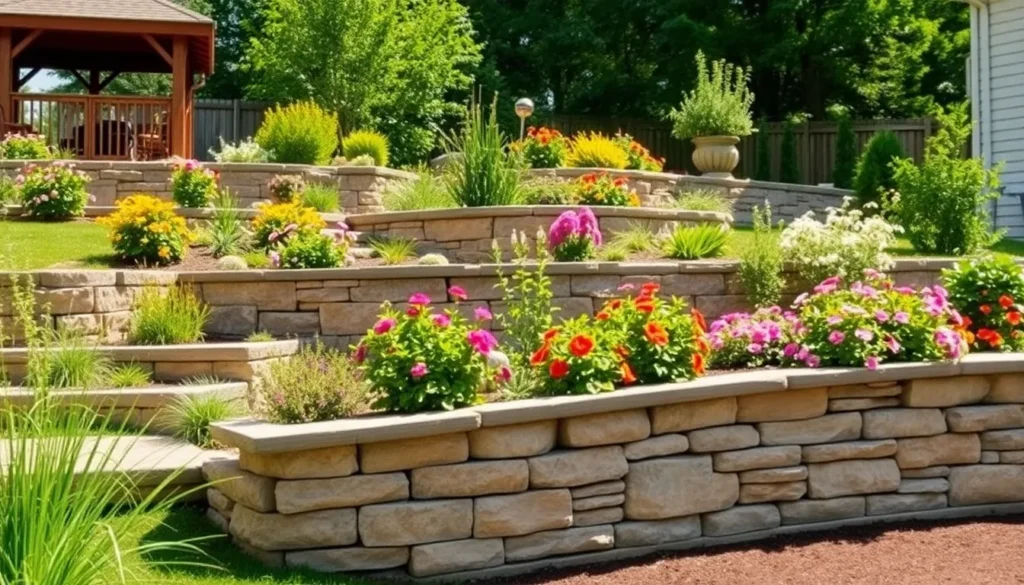Transforming sloped terrain into a stunning garden paradise doesn’t have to be a daunting challenge. Retaining walls offer the perfect solution for creating functional outdoor spaces while adding architectural interest to your industry design.
We’ve discovered that the right retaining wall can completely revolutionize your garden’s potential. Whether you’re dealing with erosion issues steep slopes or simply want to create defined planting areas these structures serve as both practical answers and beautiful focal points. From natural stone installations to modern concrete designs the possibilities are endless.
The best part? Garden retaining walls aren’t just about function – they’re opportunities to showcase your creativity and enhance your property’s value. We’ll explore innovative ideas that work for every budget skill level and design preference helping you turn challenging terrain into your garden’s greatest asset.
Natural Stone Retaining Wall Ideas for Garden Terracing
Natural stone offers timeless elegance and unmatched durability for garden terracing projects. We’ll explore three effective approaches that transform steep terrain into stunning industry features.
Fieldstone and Boulder Arrangements
Creating organic retaining walls with fieldstone and boulders delivers authentic rustic charm that complements natural garden settings. We recommend selecting stones with similar color tones but varying sizes to achieve visual balance while maintaining structural integrity.
Positioning larger boulders at the base provides essential stability for fieldstone walls up to 3 feet tall. We’ve found that alternating stone sizes creates natural pockets perfect for planting alpine flowers like sedums or creeping thyme between gaps.
Collecting local fieldstone often proves most cost effective and ensures your retaining wall blends seamlessly with existing industry features. We suggest gathering stones during dry weather when their true colors and textures are most visible.
Arranging fieldstone walls requires careful consideration of each stone’s natural shape and weight distribution. We always place the flattest side down and fit irregularly shaped stones together like puzzle pieces for maximum stability.
Dry Stack Stone Construction
Building dry stack retaining walls eliminates the need for mortar while creating flexible structures that allow natural drainage and seasonal movement. We recommend this technique for walls under 4 feet tall where proper stone selection and placement are crucial.
Selecting appropriate stones for dry stacking means choosing flat pieces with at least one straight edge for easier fitting. We typically use limestone, sandstone, or granite blocks that weigh between 20 to 50 pounds for manageable handling.
Laying the foundation course requires excavating a level trench and placing larger stones as anchors every 6 to 8 feet along the wall’s length. We ensure each foundation stone sits firmly without rocking or shifting under pressure.
Staggering joint patterns throughout each course prevents weak points that could compromise wall stability over time. We overlap stones by at least 6 inches and fill gaps with smaller stone chips to eliminate movement between layers.
Installing drainage materials behind dry stack walls prevents hydrostatic pressure buildup that causes structural failure. We place perforated drain pipes at the base and backfill with graded gravel before adding soil.
Mortared Stone Wall Techniques
Constructing mortared stone walls provides maximum strength and longevity for taller retaining structures up to 8 feet high. We use this method when creating formal garden terraces that require precise lines and permanent stability.
Preparing concrete footings establishes the foundation for mortared stone walls that must extend below the frost line in cold climates. We typically pour footings twice the wall’s width and at least 6 inches thick for adequate support.
Mixing appropriate mortar combines Portland cement, lime, and sand in ratios that accommodate stone weight and weather conditions. We adjust consistency to hold stones firmly while allowing time for precise positioning and leveling.
Setting stones systematically involves applying mortar beds and checking each course for level and plumb alignment. We clean excess mortar from visible joints within 30 minutes to prevent permanent staining on stone surfaces.
Finishing mortar joints requires tooling techniques that enhance both appearance and weather resistance. We typically use concave or flush joint profiles that shed water effectively while complementing the stone’s natural character.
Curing mortared walls properly ensures long term durability through controlled moisture retention over 7 to 14 days. We protect fresh mortar from direct sunlight and extreme temperatures using plastic sheeting or damp burlap coverings.
Timber Retaining Wall Solutions for Garden Landscapes
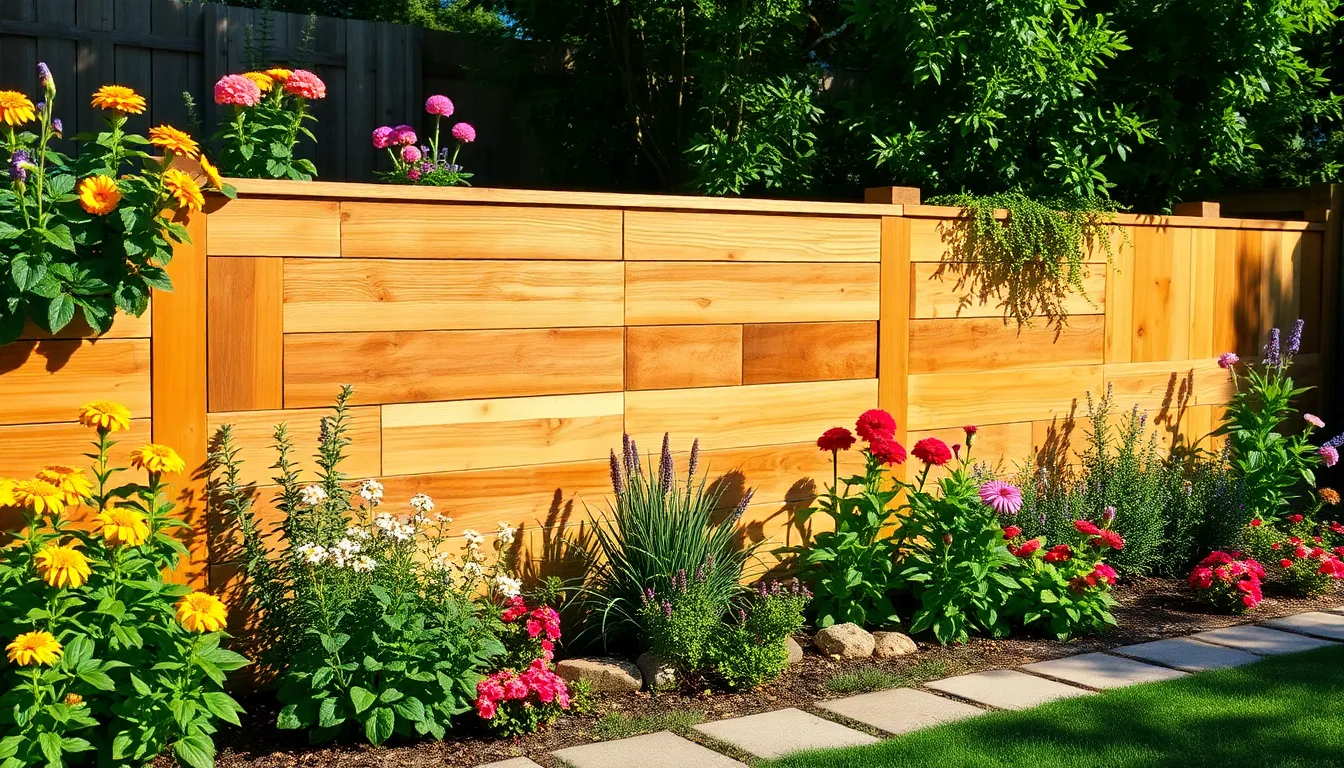
Timber offers an accessible and versatile approach to building retaining walls that complement natural garden settings. Wood provides excellent design flexibility while maintaining cost effectiveness for most landscaping projects.
Pressure-Treated Lumber Options
Pressure treated lumber delivers exceptional value as a retaining wall material for budget conscious gardeners. This wood type undergoes chemical treatment processes that create resistance to rot and insect damage, extending the lifespan significantly compared to untreated alternatives.
Cost effectiveness makes pressure treated lumber particularly attractive for longer retaining wall projects. We can expect these walls to last 15-20 years with proper installation and maintenance routines.
Environmental considerations require careful evaluation when selecting pressure treated options. Chemical treatments may leach into surrounding soil over time, potentially affecting nearby plants and garden ecosystems. Modern pressure treated lumber uses safer chemical formulations than older versions, reducing environmental impact concerns.
Cedar and Redwood Natural Choices
Western red cedar stands out as nature’s premium retaining wall material due to its inherent rot resistance properties. Natural oils within cedar wood fibers provide built in protection against moisture damage and insect infestations without requiring chemical treatments.
Redwood offers similar natural durability characteristics while delivering distinctive reddish coloring that ages gracefully over time. Both cedar and redwood develop attractive silvery gray patinas when left unstained, creating rustic charm in garden landscapes.
Beauty and longevity combine to make these natural wood choices ideal for visible retaining walls near patios or entertainment areas. We find these premium timber options particularly suitable for terraced garden designs where aesthetic appeal matters as much as structural function.
Environmental friendliness represents a major advantage since these woods require no chemical treatments. Garden soil remains uncontaminated, supporting healthy plant growth in adjacent planting areas.
Railroad Tie Alternatives
Traditional railroad ties contain creosote treatments that pose important environmental and health risks in garden applications. Creosote chemicals can harm plant roots and contaminate soil, making authentic railroad ties unsuitable for landscaping projects.
Composite materials provide excellent railroad tie substitutes without environmental drawbacks. These engineered products combine recycled wood fibers with plastic polymers, creating durable retaining wall components that resist moisture and insect damage.
Recycled plastic lumber offers another eco friendly alternative that mimics the substantial appearance of railroad ties. Manufacturing processes transform post consumer plastic waste into sturdy building materials suitable for retaining wall construction.
Concrete railroad tie replicas deliver authentic appearance without chemical concerns. These precast units provide the massive look of traditional railroad ties while offering superior durability and environmental safety for garden applications.
Modern Concrete Block Retaining Wall Designs
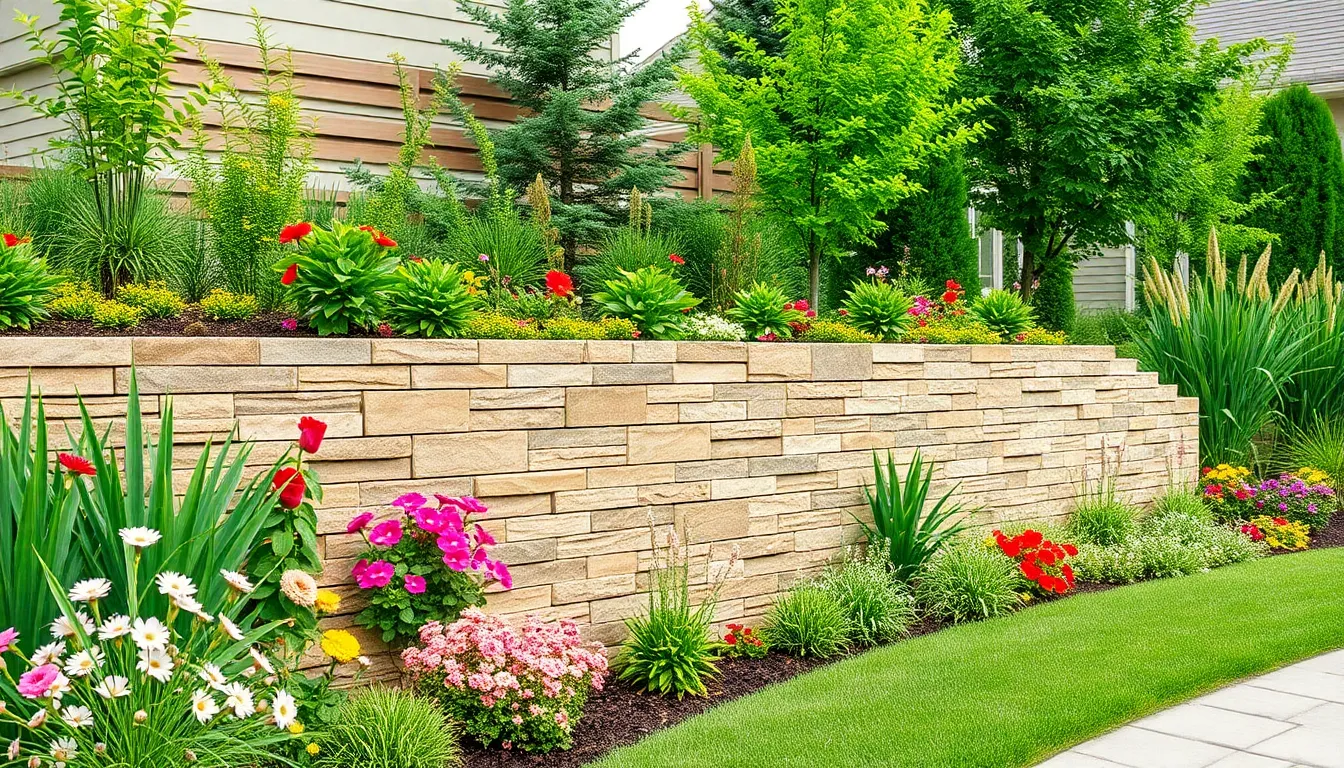
Contemporary concrete blocks offer versatile answers that combine durability with striking visual appeal. These innovative systems provide excellent alternatives to traditional materials while maintaining the structural integrity needed for effective soil retention.
Interlocking Block Systems
Interlocking blocks create seamless installations that we can customize to match any garden aesthetic. These systems snap together without mortar, making them perfect for DIY enthusiasts who want professional-looking results. Installation becomes straightforward since each block locks into the next, eliminating guesswork about proper alignment.
Customization options include various patterns like running bond, herringbone, and basket weave designs. We can mix different block sizes within the same wall to create visual interest and texture variation. Color choices range from natural earth tones to bold contemporary shades, allowing seamless integration with existing industry elements.
Durability benefits make interlocking systems ideal for both small garden borders and large-scale terracing projects. The blocks distribute weight evenly across the entire structure, reducing pressure points that could cause traditional walls to fail. Maintenance requirements stay minimal since individual blocks can be replaced if damaged without dismantling entire sections.
Decorative Concrete Options
Stamped concrete blocks replicate the appearance of natural materials like fieldstone, brick, or wood planking. We can achieve realistic textures that fool the eye while maintaining concrete’s superior strength and longevity. These blocks work exceptionally well when we want the rustic charm of natural materials without their higher maintenance requirements.
Exposed aggregate finishes reveal decorative stones embedded within the concrete surface. This technique creates visual depth and provides excellent slip resistance for stepped retaining wall designs. We often see river rock, crushed granite, or recycled glass aggregates used to complement exact garden color schemes.
Colored concrete blocks eliminate the need for painting or staining while providing consistent color throughout the material. Integral coloring prevents chipping and fading issues common with surface treatments. Popular options include warm earth tones that blend naturally with soil and plantings, plus contemporary grays that complement modern architectural elements.
Precast Panel Answers
Precast concrete panels deliver sleek, uniform appearances that work beautifully in contemporary garden designs. These panels arrive ready to install, significantly reducing construction time compared to cast-in-place alternatives. We can complete entire retaining wall projects in days rather than weeks.
Texture variations include smooth finishes for minimalist aesthetics, wood grain patterns for organic appeal, and geometric designs for artistic focal points. Manufacturers like Techo-Bloc offer specialized options such as the Iconic Wall with textured surfaces that pair perfectly with water features, creating serene garden ambiances.
Custom sizing accommodates walls of virtually any height or length configuration. Panels typically measure 4 to 8 feet wide and can stack to create walls up to 20 feet tall with proper engineering. This flexibility makes precast systems suitable for everything from simple garden borders to major slope stabilization projects.
Creative Brick Retaining Wall Concepts for Gardens
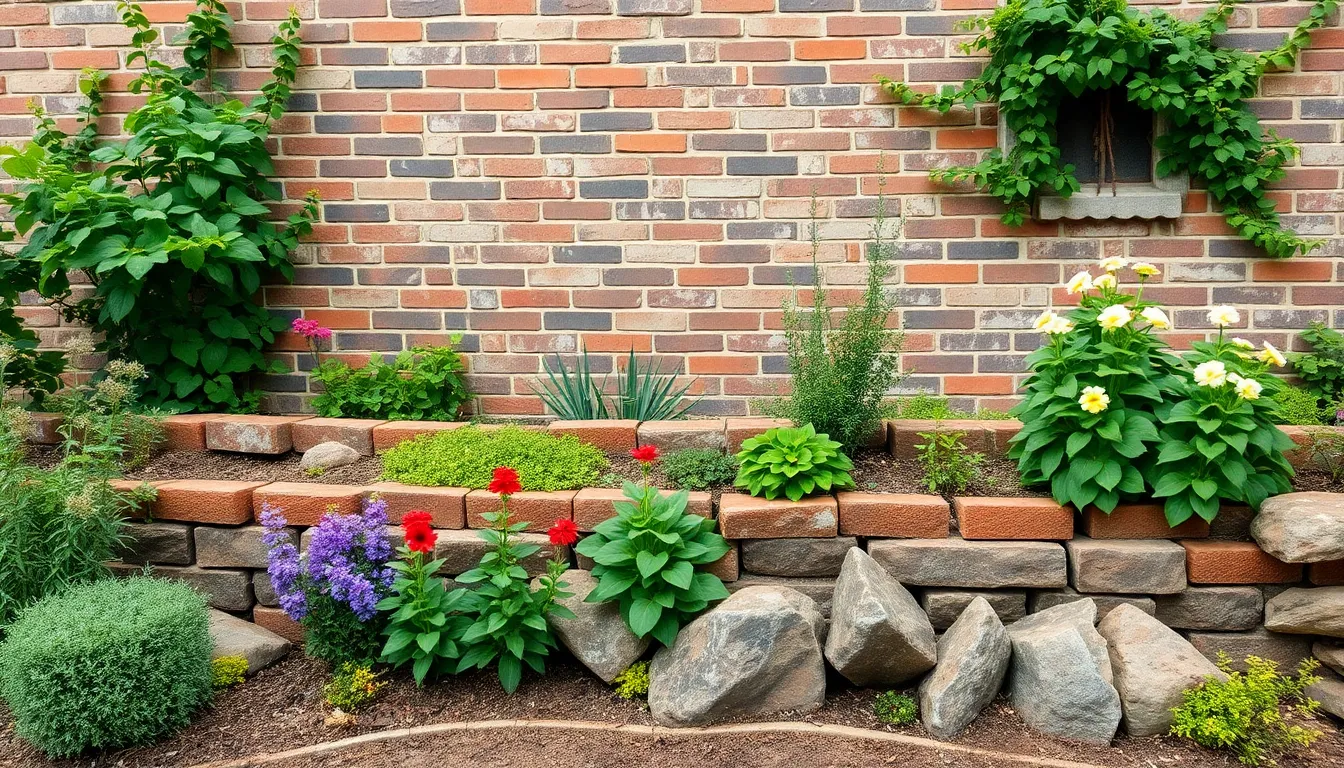
Brick retaining walls bring timeless charm and structural reliability to garden landscapes. We’ll explore three distinct approaches that showcase brick’s versatility in creating functional yet beautiful terraced spaces.
Traditional Red Brick Patterns
Classic brick patterns like running bond create enduring appeal in garden retaining walls. Running bond involves offsetting each course by half a brick length, providing excellent structural stability while maintaining visual balance. Herringbone patterns offer a more decorative approach, with bricks laid at 45-degree angles to form distinctive zigzag designs.
Traditional red brick walls complement various garden styles from English cottage to colonial landscapes. We recommend using standard modular bricks measuring 2¼ × 3¾ × 8 inches for optimal proportions. These patterns work exceptionally well for walls up to 4 feet in height, where their geometric precision creates stunning focal points alongside plantings like hostas, ferns, or climbing roses.
Recycled Brick Applications
Recycled bricks transform garden retaining walls into characterful features with authentic weathered textures. These reclaimed materials reduce environmental impact while delivering unique patina that new bricks can’t replicate. We find recycled bricks particularly effective for creating rustic garden themes or blending walls seamlessly into established landscapes.
Weathered surfaces on recycled bricks provide natural grip for mortar, ensuring strong bonds during construction. Sources include demolished buildings, old industrial sites, and specialty salvage yards where you can find bricks with varying colors and textures. We suggest selecting bricks with similar dimensions to maintain consistent coursing, though slight variations add to the authentic character.
Mixed Material Brick Combinations
Combining brick with complementary materials creates visually striking retaining walls that enhance garden aesthetics. Stone caps paired with brick bases provide elegant contrast while protecting the wall structure from weather damage. Wood elements like cedar posts or horizontal boards can soften brick’s rigid appearance, creating warmer transitions between hardscape and planted areas.
Concrete block foundations topped with brick veneer offer cost-effective answers for taller retaining walls. We recommend using natural limestone or fieldstone accents to break up large brick expanses, adding texture variation that draws the eye. Metal elements such as steel posts or decorative panels can introduce contemporary touches to traditional brick construction, perfect for modern garden designs requiring both function and artistic flair.
Eco-Friendly Living Retaining Wall Ideas
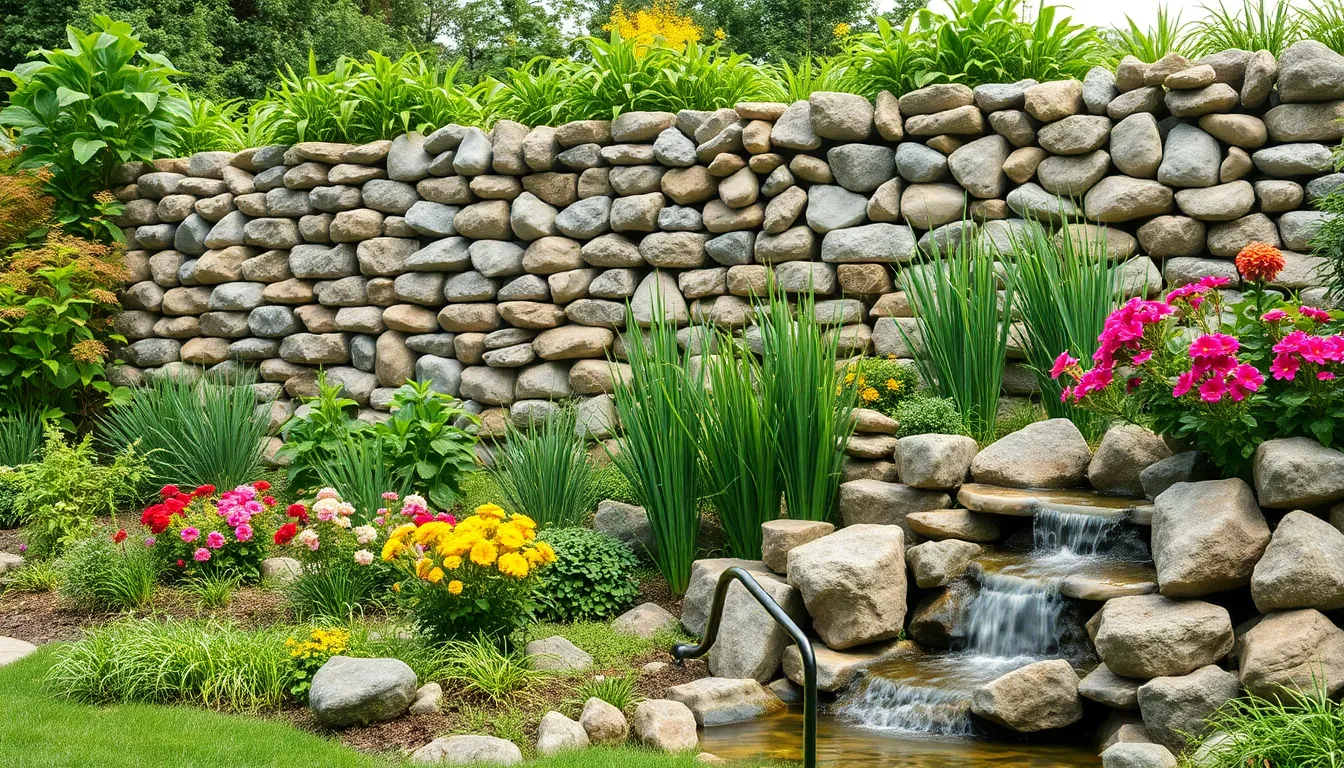
Sustainable retaining wall answers combine environmental responsibility with stunning garden aesthetics. We can create beautiful terraced landscapes while reducing our carbon footprint through thoughtful material choices and innovative design approaches.
Gabion Basket Installations
Wire mesh baskets filled with natural stone create robust retaining walls that blend seamlessly with garden environments. Gabion installations offer exceptional durability while allowing water drainage through their porous structure. We recommend using locally sourced stone to minimize transportation costs and environmental impact.
Recycled concrete and brick materials provide cost effective alternatives to traditional stone fill. These repurposed materials reduce landfill waste while maintaining structural integrity. Construction debris from demolition projects often works perfectly for gabion applications.
Aesthetic versatility makes gabions suitable for both modern and rustic garden designs. We can create striking visual contrasts by mixing different stone colors and sizes within the baskets. The industrial appearance softens naturally as vegetation grows around and through the structure.
Green Wall Planting Systems
Living retaining walls integrate structural support with flourishing plant ecosystems. The Rootlok system allows us to incorporate grasses, plants, and small shrubs directly into wall construction, promoting biodiversity while preventing soil erosion. These installations create habitat corridors for beneficial insects and small wildlife.
Modular planting systems offer flexibility in design and maintenance requirements. We can easily replace individual sections or change plant varieties based on seasonal preferences or growth patterns. Built in irrigation systems ensure consistent moisture delivery to embedded vegetation.
Water features complement green walls by creating harmonious nature focused environments. Cascading fountains or gentle streams enhance the sensory experience while providing additional moisture for plant growth. These combinations transform functional retaining walls into stunning garden focal points.
Bioengineered Slope Answers
Geotextile materials stabilize slopes without requiring massive structural elements. These synthetic fabrics reinforce soil while allowing natural drainage patterns to continue. We recommend combining geotextiles with native plantings for maximum erosion control effectiveness.
Native vegetation establishes natural slope stabilization while supporting local ecosystems. Deep rooted plants like native grasses and shrubs bind soil particles together more effectively than non native alternatives. Local wildlife benefits from familiar food sources and nesting habitats.
Hybrid approaches combine engineered materials with biological answers for enhanced performance. We can install geotextiles as immediate stabilization while native plants establish their root systems. This strategy provides both short term protection and long term sustainability for challenging slope conditions.
Budget-Friendly DIY Retaining Wall Projects
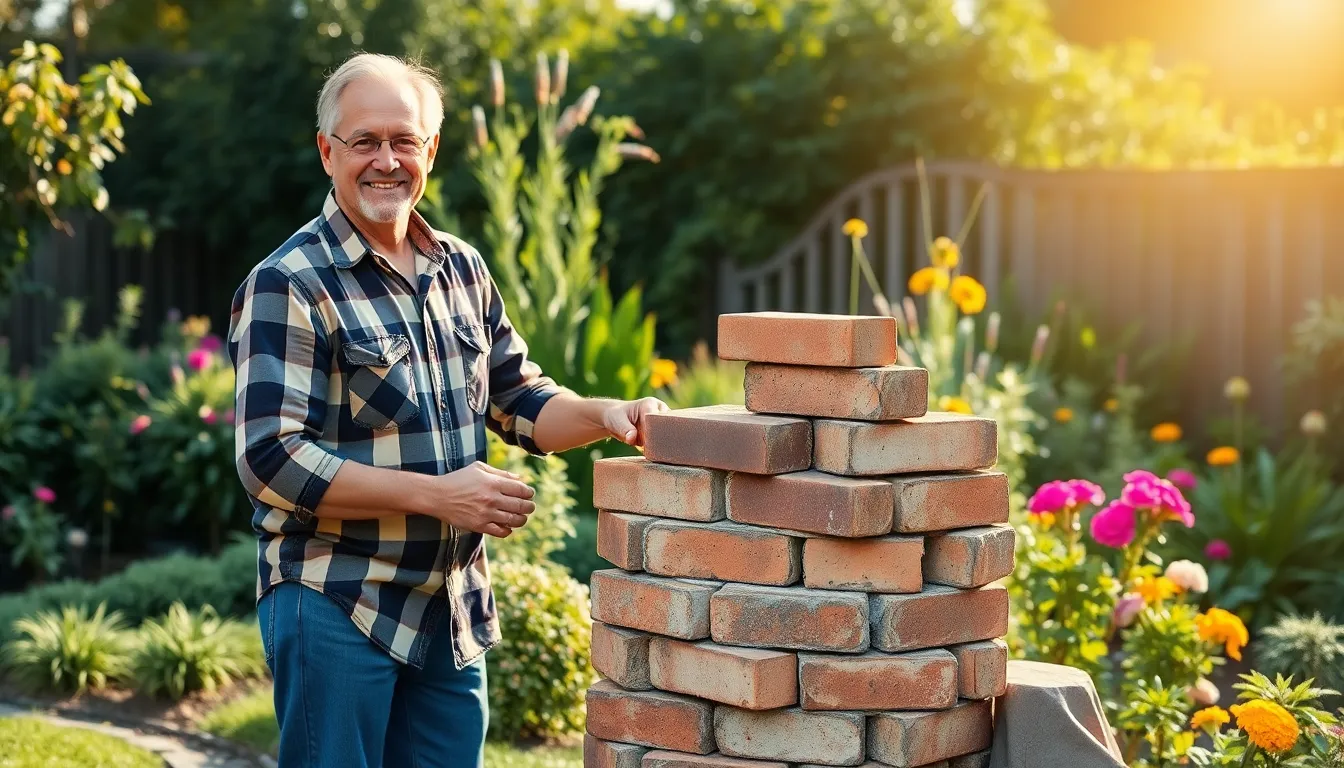
Building retaining walls doesn’t have to expensive when we use smart strategies and creative approaches. We can create functional and attractive garden walls using recycled materials, simple construction methods, and basic tools that most homeowners already own.
Recycled Material Options
Reclaimed bricks offer an excellent starting point for budget-conscious retaining wall projects. We can source these materials from demolition sites, architectural salvage yards, or online marketplaces at a fraction of new brick costs. Old concrete pieces make another practical choice, providing durability while reducing construction waste from our environment.
Railroad ties present a classic recycled option, though we should verify they’re safe for garden use and haven’t been treated with harmful chemicals. Salvaged stone creates beautiful rustic walls that blend naturally with garden landscapes. We can stack these materials without mortar for simple projects or use mortar for more permanent installations, depending on our design goals and skill level.
Simple Stacked Answers
Stacking stone blocks or bricks without mortar creates the most straightforward retaining wall approach for beginners. We can build these walls as raised garden beds or decorative borders, making them easy to install and modify as our garden needs change. This technique works particularly well for walls under three feet in height.
Vertical placement of wide, flat stones requires only shallow trenching and sand compacting as a foundation. We bury these stones partially in the ground for stability, creating clean lines that define garden spaces effectively. Multi-tiered designs add visual interest while providing better stability on sloped terrain, breaking up longer runs into manageable sections that prevent soil pressure buildup.
Minimal Tool Requirements
Basic retaining wall construction needs only essential tools that most homeowners possess: a shovel, level, trowel, and compacting tool. We don’t need complex machinery or expensive equipment rentals for small garden walls under four feet tall. These fundamental tools handle excavation, leveling, and finishing work for most DIY projects.
Simple stacked stone walls require even fewer tools, making them perfect weekend projects for beginners. We need minimal digging and leveling equipment, plus a wheelbarrow for moving materials efficiently. A rubber mallet helps adjust stone placement without causing damage, while a string line ensures straight, professional-looking results throughout our construction process.
Curved and Artistic Retaining Wall Designs
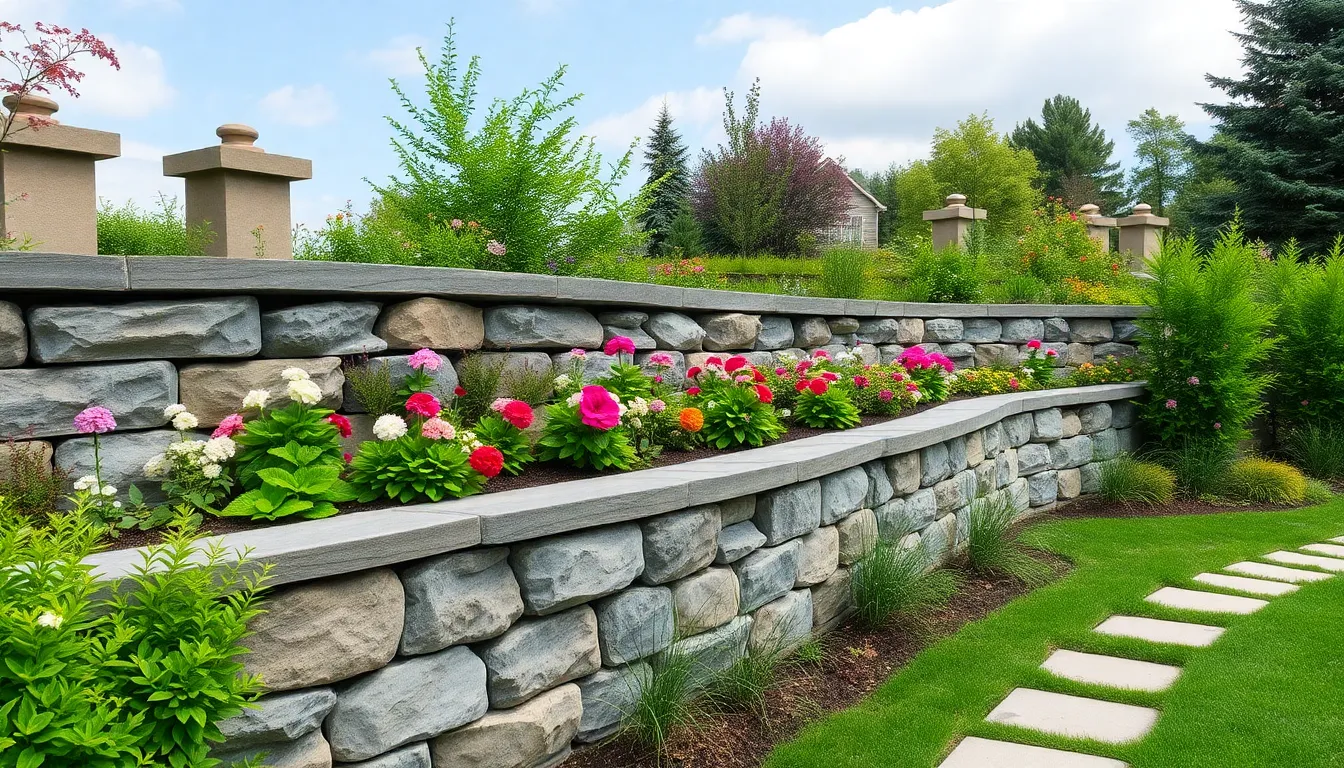
Moving beyond traditional straight walls opens up exciting possibilities for creative garden features. Curved retaining walls bring flowing elegance to landscapes while maintaining structural integrity.
Serpentine Wall Patterns
Serpentine designs create stunning visual movement that transforms ordinary retaining walls into garden art. We recommend incorporating these curved lines to add unique character while maintaining full functionality for soil retention.
Natural stone works exceptionally well for serpentine patterns since individual stones can be shaped and fitted to follow curved forms. Curved retaining walls require careful planning to ensure proper drainage and structural stability at each bend.
The undulating shape mimics natural industry formations like riverbanks and hillsides. Serpentine walls also create intimate pocket gardens between curves, perfect for showcasing specialty plants or creating cozy seating areas.
Tiered Garden Integration
Multi-tiered retaining walls maximize vertical growing space while creating dramatic industry features. We suggest building multiple levels to establish distinct planting zones that enhance your garden’s visual appeal.
Each tier can showcase different plant varieties, from groundcover succulents on lower levels to taller perennials and shrubs on upper terraces. Tiered designs work particularly well on steep slopes where single tall walls might appear overwhelming.
Strategic placement of gardening beds within each tier allows for specialized growing conditions. Upper tiers typically receive more sunlight, making them ideal for sun-loving vegetables and herbs, while lower levels provide perfect conditions for shade-tolerant plants.
The stepped approach also improves water management by slowing runoff and allowing gradual absorption into each level. Multiple tiers create natural pathways and viewing areas throughout your sloped garden space.
Decorative Cap Installations
Stone post caps add sophisticated finishing touches that protect wall structures from weather damage. We choose decorative caps to complement existing garden materials while providing essential weatherproofing for end posts.
Concrete and brick caps offer versatile options that match various architectural styles and color schemes. Natural stone caps blend seamlessly with boulder retaining walls, while manufactured caps provide consistent sizing and uniform appearance.
Proper cap installation prevents water infiltration that can cause structural damage over time. Decorative elements like carved details or contrasting colors transform functional components into attractive design features.
End post caps also serve as natural transition points between different garden sections. They frame walkways and pathways while adding vertical interest that draws the eye upward through your terraced industry.
Drainage Considerations for Garden Retaining Walls
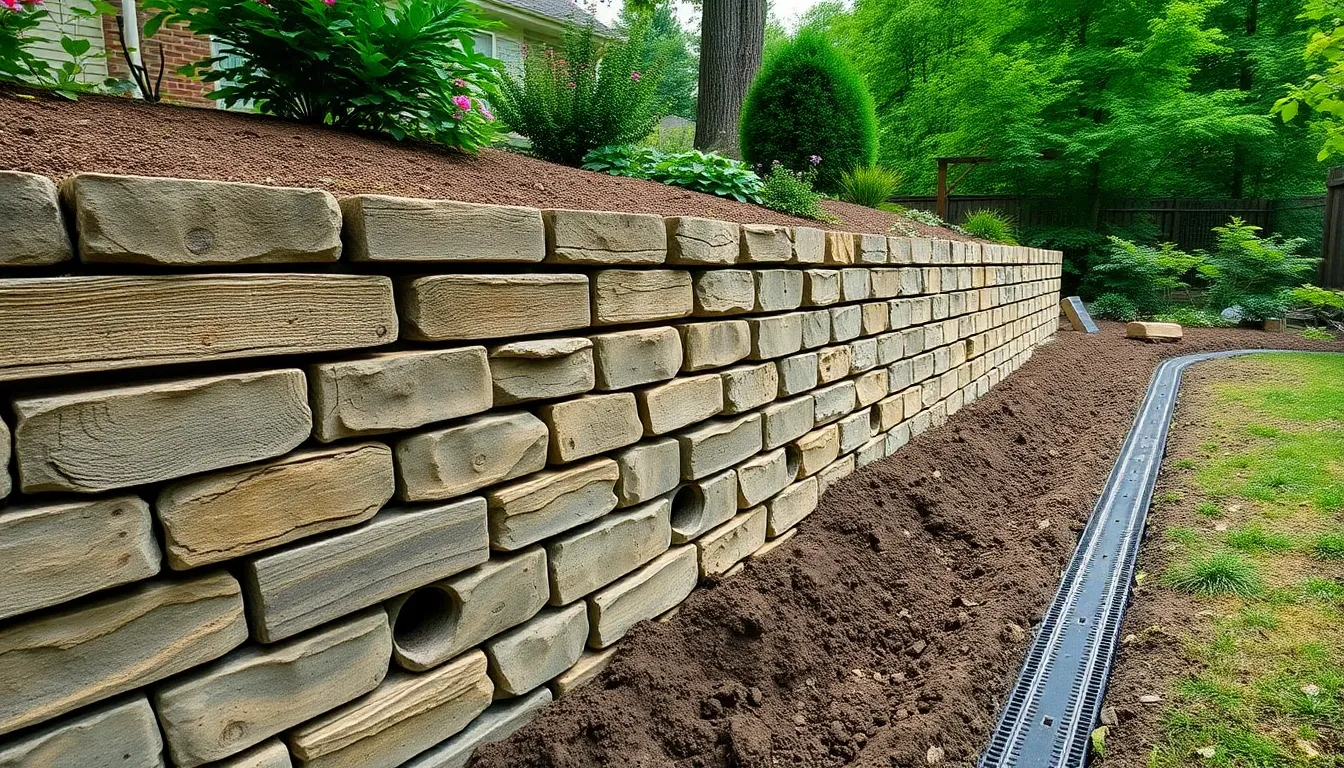
Proper drainage prevents water buildup that can compromise your retaining wall’s structural integrity and longevity. We’ll explore three essential drainage techniques that ensure your garden retaining walls remain stable and effective for years to come.
Weep Hole Installation
Installing weep holes creates critical drainage points that prevent hydrostatic pressure from building behind your retaining wall. We recommend placing these small openings every 6 to 8 feet along the wall’s base, allowing trapped water to escape naturally. Drill holes approximately 3 inches in diameter through your wall blocks or materials, ensuring they angle slightly downward for optimal water flow.
Position weep holes at least 6 inches above ground level to prevent clogging from soil and debris. We suggest using PVC pipe sleeves or gravel pockets behind each hole to maintain consistent drainage performance. Regular maintenance involves checking these openings seasonally and clearing any blockages that might impede water flow.
French Drain Systems
Constructing a French drain at your retaining wall’s base provides comprehensive water management for larger garden projects. We begin by excavating a trench along the wall’s entire length, typically 12 to 18 inches deep and 8 to 12 inches wide. Install perforated drainage pipe in this trench, surrounding it with coarse gravel to help water collection and redirection.
Connect your French drain system to a suitable outlet point such as a storm drain or natural water flow area. We recommend using industry fabric to separate the gravel from surrounding soil, preventing fine particles from clogging the drainage system. Slope the pipe at least 1 inch per 10 feet of length to ensure proper water movement away from your wall structure.
Proper Base Preparation
Establishing a solid foundation prevents settling issues that can compromise your retaining wall’s stability and drainage effectiveness. We start by excavating the base area to a depth equal to one-tenth of the wall’s planned height, with a minimum depth of 6 inches for most garden applications. Create a level base using compacted gravel or coarse sand, ensuring consistent support across the entire wall length.
Compact your base material in 2 to 3 inch lifts using a plate compactor or hand tamper for smaller projects. We verify the base level using a spirit level and make adjustments before beginning wall construction. Add a thin layer of leveling sand on top of the compacted gravel base to provide a smooth, even surface for your first course of wall materials.
Plant Integration Ideas for Retaining Wall Gardens
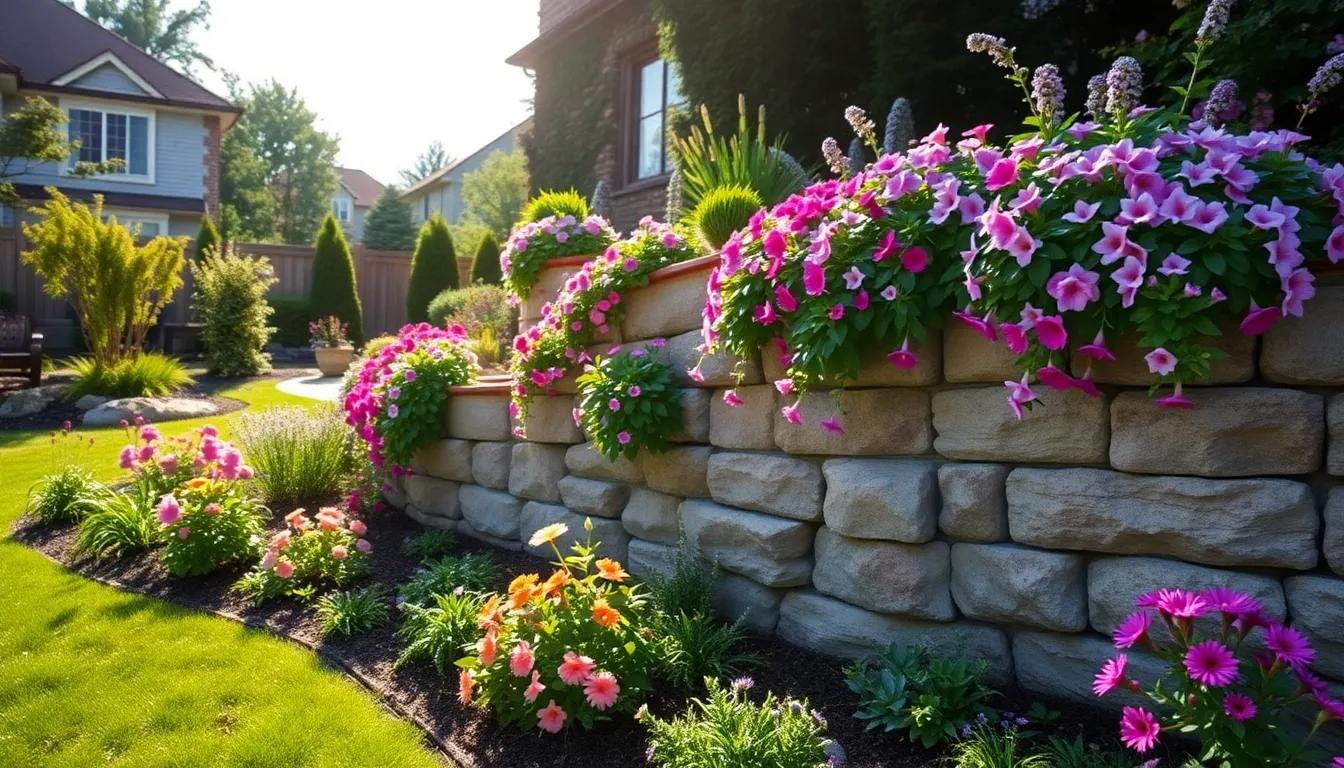
Plant integration transforms functional retaining walls into living garden features that enhance both beauty and ecological value. Incorporating vegetation into wall design creates seamless transitions between hardscape and industry elements.
Cascading Plant Selections
Cascading plants create stunning visual effects when positioned at the top of retaining walls, allowing foliage to spill gracefully over edges. These trailing selections break up solid wall appearances while adding natural texture and movement to garden spaces. Groundcovers like creeping phlox and trailing vinca provide excellent coverage and seasonal blooms. Vines such as Virginia creeper and Boston ivy establish quickly and offer year-round structure. Perennial flowers including trailing petunias and lobelia deliver continuous color throughout growing seasons.
Selecting plants requires careful consideration of sun and shade conditions along different wall sections. Morning sun areas support sun-loving cascading varieties, while shadier spots accommodate ferns and hostas with drooping characteristics. Evergreen cascading plants maintain visual interest during winter months when deciduous options go dormant.
Pocket Planting Techniques
Pocket planting maximizes growing space by utilizing small recessed areas within retaining wall blocks or natural stone gaps. This technique proves especially valuable when garden space is limited and vertical growing opportunities become essential. Stone blocks can be arranged to create deliberate planting pockets during construction, while natural stone walls often provide existing crevices for plant installation.
Succulents thrive in these compact spaces, requiring minimal soil and tolerating drainage challenges common in wall pockets. Small ferns establish well in shadier pocket locations, adding delicate texture to rough stone surfaces. Herbs like thyme and oregano flourish in sunny wall pockets, providing both culinary value and aromatic benefits.
Proper soil preparation ensures pocket plantings succeed long-term, with well-draining growing medium preventing root rot in confined spaces. Plants selected for pocket installation should remain compact and avoid aggressive spreading that could compromise wall structure.
Top Cap Garden Spaces
Top cap areas provide valuable planting opportunities along the flat upper surfaces of retaining walls. These narrow garden spaces accommodate small potted plants, decorative shrubs, or flowering perennials that add finishing touches to wall installations. Potted arrangements offer flexibility for seasonal changes, allowing gardeners to rotate plants based on blooming schedules or weather requirements.
Small shrubs planted directly into top cap areas create permanent industry features that require minimal maintenance once established. Boxwood, dwarf conifers, and compact flowering shrubs work well in these elevated positions. Flowering plants like marigolds, impatiens, and begonias provide seasonal color that’s easily viewed from various garden angles.
Maximizing vertical garden space becomes particularly important on sloped properties where traditional planting areas may be limited. Top cap gardens effectively use otherwise unused space while visually connecting retaining walls to surrounding industry elements.
Conclusion
We’ve explored countless possibilities for transforming your sloped industry into stunning terraced gardens. From natural stone arrangements to eco-friendly gabion systems these retaining wall answers offer something for every budget and skill level.
The key to success lies in matching your chosen materials and techniques to your exact site conditions and aesthetic preferences. Whether you’re drawn to traditional brick patterns or modern concrete blocks proper drainage and thoughtful plant integration will ensure your walls thrive for years to come.
Your retaining wall project represents more than just erosion control—it’s an opportunity to create beautiful functional outdoor spaces that increase property value and enhance your daily enjoyment of your industry.
Frequently Asked Questions
What are the main benefits of retaining walls in sloped gardens?
Retaining walls address erosion control, create defined planting areas, and serve as attractive focal points in garden design. They enhance both functionality and aesthetic appeal while maximizing challenging landscapes. These structures offer opportunities for creativity, increase property value, and transform unusable sloped terrain into beautiful, functional garden spaces.
What materials can I use for natural stone retaining walls?
You can use fieldstone and boulder arrangements, dry stack stone construction, or mortared stone wall techniques. Focus on selecting stones that fit well together, arrange them for stability, and ensure proper drainage. The choice depends on your wall height requirements, budget, and design preferences for your garden landscape.
Are timber retaining walls environmentally friendly?
Timber walls can be eco-friendly when using sustainable options like cedar and redwood, which offer natural durability. While pressure-treated lumber is cost-effective, consider environmental impacts. Alternatives include composite materials and recycled plastic lumber, which provide longevity without contributing to deforestation while maintaining structural integrity.
What are gabion basket retaining walls?
Gabion baskets are wire mesh containers filled with natural stone that create durable, well-draining retaining walls. They’re eco-friendly, cost-effective, and blend naturally with landscapes. These systems are easy to install, allow for vegetation growth, and provide excellent drainage while maintaining structural stability for slope retention.
Can I build a retaining wall on a budget?
Yes, budget-friendly options include using recycled materials like reclaimed bricks, old concrete, and salvaged stone. Simple stacking techniques without mortar make construction accessible for beginners. Minimal tool requirements mean you can complete these projects with basic equipment, making retaining wall construction an achievable weekend DIY endeavor.
How important is drainage for retaining walls?
Proper drainage is crucial for structural integrity and longevity. Essential techniques include installing weep holes to prevent hydrostatic pressure, constructing French drain systems for comprehensive water management, and ensuring proper base preparation. Without adequate drainage, water buildup can cause wall failure and compromise the entire structure.
What plants work best with retaining walls?
Choose cascading plants for visual drama, utilize pocket planting techniques for limited space, and create top cap gardens on flat wall surfaces. Select plants based on sun exposure, water requirements, and mature size. Native plants often work best as they’re adapted to local conditions and require less maintenance.
Can retaining walls be curved or artistic?
Absolutely! Serpentine wall patterns create visual movement and intimacy in garden spaces. Curved designs allow for tiered garden integration, maximizing vertical growing space and improving water management. Decorative cap installations enhance aesthetic appeal while protecting walls from weather damage, providing sophisticated finishing touches.

